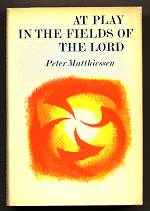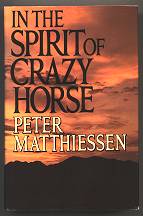Collecting Peter Matthiessen
 For four decades, Peter Matthiessen has been carving out
a unique place in American letters and putting together a body of work that
is unparalleled in its range and diversity and in its combination of literary
and social impact.
For four decades, Peter Matthiessen has been carving out
a unique place in American letters and putting together a body of work that
is unparalleled in its range and diversity and in its combination of literary
and social impact.
In the early Fifties, Matthiessen was a member of the "second wave" of American expatriate writers to settle in Paris, after the "Lost Generation" of Hemingway, Fitzgerald, Stein and Pound. With George Plimpton, Matthiessen founded The Paris Review, still one of the most important literary journals being published. His first two novels--Race Rock and Partisans, published in 1954 and 1955, respectively--were greeted as "promising" efforts by a young writer seemingly destined for literary success. But his third book, Wildlife in America, which was a complete departure from his earlier work and an extremely ambitious effort in a entirely different arena, showed that Matthiessen had his eyes on more than just literary success, and it pointed the way that he has followed since--that of an iconoclastic individualist, unattached to any particular "school" of writing, and breaking new ground at will. More often than not, time has shown Matthiessen to have been ahead of his time in his perceptions and concerns, and it is not unfair to say that in his own quiet way--befitting one who has become a Zen priest in the past two decades--he has helped shape the literary and political agenda of an entire generation of writers and readers.
Wildlife in America, Matthiessen's acclaimed third book, was his first of nonfiction. It is a study of the effects of the coming of the white man on the fauna of North America, paying particular attention to the negative effects--the species wiped out, the habitats destroyed. The book became a part of the permanent library of The White House and, like Rachel Carson's classic The Silent Spring, written a few years later, it helped provide the foundation from which the conservation movement in this country in the 1960s was launched. It was years before the ecological concerns implicit and explicit in this landmark book became a part of the general public consciousness. One might even argue that they have yet to be fully appreciated. Wildlife in America was reissued in a revised and expanded edition in 1984, and Matthiessen's perceptions still seemed fresh and far-seeing and not the slightest bit outdated.
Matthiessen's next book, in 1961, was again a novel--Raditzer, a short but powerful tale of good and evil--but he seemed to be straining at the confines of fiction and later the same year he published The Cloud Forest, an engaging account of his travels in the South American bush--part travelogue, part adventure story and part anthropology and natural history. The Cloud Forest was the first of a number of books Matthiessen has written that combine those disparate elements into a coherent, well-written personal account that reveals a fully engaged individual testing his own limits--and by extension our own social constraints and cultural biases--and reporting back on what he has found. The following year his second such account was published--Under the Mountain Wall: A Chronicle of Two Seasons in the Stone Age--combining elements of anthropological study with a personal narrative of the Harvard-Peabody Expedition to New Guinea, of which Matthiessen was a member.
Of interest to collectors is the fact that Under the Mountain Wall has a little-known issue point in the first edition: early copies have the photographs that were supposed to follow the text wrongly placed in the middle of the book. The publisher corrected the error, and the second issue has the photos correctly placed at the end. Apparently, however, the publisher sold the first issue copies to one of the two book clubs that issued the title, The Natural History Book Club or the Mid-Century Book Club, which left the photos erroneously placed but tipped in a new Table of Contents page. At the bottom of the page is the statement "BOOK CLUB EDITION," the only place it is indicated in the volume. According to a note the publisher included with a review copy, Matthiessen was adamant that the narrative not be interrupted by photographs, and the error was corrected at his request--which gives a sense of his engagement with the material not only as a scholar but as a writer, concerned not only with content but also with style and aesthetic.

With his following book, At Play in the Fields of the Lord, published in 1965, Matthiessen reached a new level of literary accomplishment. A dark, cautionary tale of the effects of a group of white people--with wildly different intentions--on a tribe of uncivilized Amazonian Indians, the book exhibited literary virtuosity along with a deep-seated knowledge of ecology and a concern for the wisdom and values of indigenous peoples, all long before such concerns became widespread or fashionable. The book was nominated for the National Book Award, and in its harsh criticism of Western values and its scorching critique of the byproducts of cultural ignorance--not to mention its convincing descriptions of tribal use of hallucinogenic drugs--it helped set the tone for the growth of the Sixties counterculture.
Matthiessen's writing continued to fuse the political and the personal and to revolve around issues of natural history. Sal Si Puedes, written in 1969, about Cesar Chavez and the United Farm Workers, represented Matthiessen's most explicitly political work to date, and it helped to popularize the farmworkers' cause. An earlier version of the text of the book, an offprint of the original two-part New Yorker article, has turned up occasionally, published by a branch of the UAW. Later, controversy and a lawsuit required the insertion of a legal disclaimer in some copies; there was a revised edition published a year after the first edition, and, ironically, the revised edition is one of Matthiessen's scarcest titles.
Such books as Shorebirds of North America, Blue Meridian and even the novel, Far Tortuga, reflected his continuing concern with ecology and natural history. Shorebirds was an encyclopedic overview of its subject, published in a large folio format and heavily illustrated with paintings of the various species of North American shorebirds. An attractive, leatherbound signed limited edition was issued of it, which turns up seldom, having been bought mostly by collectors of books on birds. Some years later Matthiessen's text was reissued in a smaller volume entitled The Wind Birds, with different illustrations. Blue Meridian chronicled an ocean-going expedition to find and film the Great White Shark for a television documentary. Far Tortuga is a novel that is almost an extended prose poem and is, in part, an elegy to the turtle fisherman of the Grand Cayman Islands, written in their dialect.
Matthiessen at one time operated a fishing boat off the coast of Long Island, and his affinity for the sea shows through repeatedly in his books--from Raditzer, a novel set aboard a ship, to the books on the shorebirds, to Oomingmak, a book for young adults about a visit to the musk ox island off the Alaskan coast, and later to Men's Lives, his homage to the fisherman of eastern Long Island. Matthiessen's one children's book--Seal Pool, published in England as The Great Auk Escape--also dealt with sea creatures, although it was set at the Central Park Zoo in New York City. Both of these titles, particularly the English edition, are extremely scarce, apparently never having received wide distribution and having disappeared almost entirely from view in the years since they were first published.
In 1978, The Snow Leopard was published and, again, Matthiessen reached a new plateau in his writing. The Snow Leopard won the National Book Award. In it, his interest in natural history was married to a sense of personal loss and grief over the recent death of his young wife. The book, which chronicles a trip to the Himalayas with naturalist George Schaller, is as much an exploration of the internal self as the outer world. Viewed through the prism of his grief, Matthiessen's reflections and meditations grope for meaning and find it in the nascent study of Zen. He has since become an active practitioner of Zen and a volume of his Zen journals was later published, called Nine-Headed Dragon River.
Then, in 1983, the various strands of Matthiessen's concerns--for the rights of indigenous peoples and the values they preserve--came together in a strident condemnation of government malfeasance in a celebrated confrontation between the FBI and a group of Sioux militants at Pine Ridge reservation in the mid-Seventies, which left two agents and one Indian dead. In the Spirit of Crazy Horse, published to considerable promotion and substantial critical attention, was effectively suppressed for 8 years by a series of lawsuits filed by two of the prominent figures in the book. Its publisher recalled the book and pulped remaining copies; plans for a paperback edition and foreign editions were scrapped. Only in the past year did the Supreme Court throw out the case, allowing the book back into print. In the meantime, two movies were made about the case, partly as a result of Matthiessen's efforts--the documentary, Incident at Oglala, and a fictional adaptation called Thunderheart. Matthiessen makes a persuasive case that Leonard Peltier, who was convicted in the case, was railroaded and that the government tampered with or withheld evidence; and as he reveals a contemporary miscarriage of justice he also attempts to show the larger historical context from the Indians' perspective, and to identify that which defines a warrior: he puts new flesh on the old idea of The Hero. Again, Matthiessen's literary ambitions and abilities were put to the service of his social concerns, which themselves are reflected back through the prism of what can only be called a multicultural spiritual sensibility.

While Crazy Horse was being suppressed and litigated, Matthiessen continued to write prolifically and in a variety of forms: he published a book of essays on Indian-related issues, had two collections of short stories assembled from older and new work, and wrote Men's Lives, a heavily illustrated homage to the fishermen of eastern Long Island and to a way of life that embodies heroic virtues and yet is dying out in our contemporary technology-oriented society. Men's Lives is Matthiessen's most interesting book bibliographically, having been published not only in a trade edition but also in two limited editions. The limited editions each comprise two volumes, one of text and one of photographs. One edition was issued in a slipcase with a list price of $200. The other was never formally published at all and was considerably more elaborate: it had a limitation page tipped in numbering each copy; it was signed by Matthiessen; each copy included an original print of one of the book's photographs, signed by the photographer; and the whole was enclosed in a folding clamshell box. Copies were given out to attendees of a $500-a-plate benefit dinner for the Historical Society that preserves the record of the lives of the fishermen depicted in the book. Few copies have appeared on the market.
Most recently, Matthiessen began a trilogy of historical novels set in south Florida at the turn of the 20th century that, again, merged his interest in natural history with his social concerns and his commitment to literature. Killing Mr. Watson--the first in the series, and based on a true historical character and incident--was greeted with near-universal praise as the writing of an important author at the top of his form. It is a compelling personal story with an ambiguous heroic character--like Leonard Peltier in Crazy Horse, or Lewis Moon in At Play in the Fields of the Lord. It is also a catalogue of the south Florida ecology at the turn of the century and, by implication, a commentary on its despoliation since then. A prodigious amount of research went into the book and it was a commercial as well as critical success, having had both a relatively large first printing and been reprinted a number of times soon after publication. A video production of Matthiessen in south Florida was shown on PBS and was later released as a home video.
Over the years, Matthiessen has written extensively for a wide variety of magazines, in various fields. His natural history writings have often appeared in Audobon; his more political pieces have shown up in The New Yorker, The New York Times Magazine, The Nation, and elsewhere; his travel pieces have appeared in such magazines as Outside and Holiday. He has recently published in Tri-Cycle, a magazine of American Buddhism.
With the body of work he has assembled, Matthiessen has taken a preeminent position among his peers as a writer of vision, with a sense of compassion and historical perspective that is unsurpassed among his contemporaries. His particular combination of interests and concerns--natural history and ecology, political freedom and the values of indigenous cultures, Zen and oriental thought as vehicles for exploring the inner self--form a constellation that has influenced not only American literature but American culture for the past three decades. In the 1960s, Peter Matthiessen was virtually alone in uniting those concerns into a coherent literary voice. Now, it is a tribute to his anticipation of the trends of our contemporary history and to his innate sense of the values that exalt us as people that there is a virtual flood of writers that are both sensitive to the natural world and to the larger issues that define us as human--the political issues as well as those that we would call spiritual. Matthiessen's vision has not only shaped his own writing, it has helped to shape the body of American literature for the past 40 years and, because his concerns have been so pointedly on-target, it seems inevitable that his effect will be felt far into the future.
Copyright © 1993 by Ken Lopez